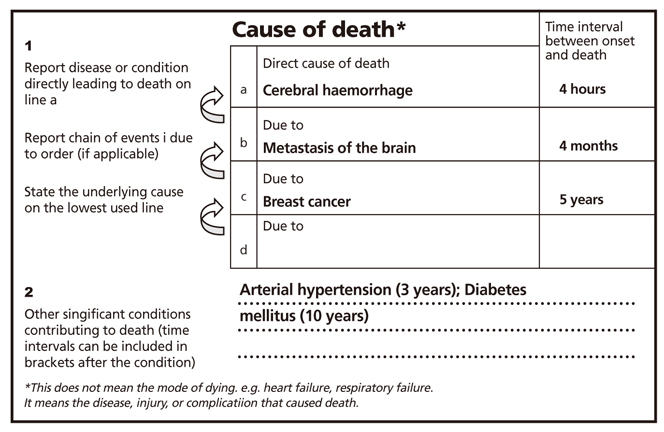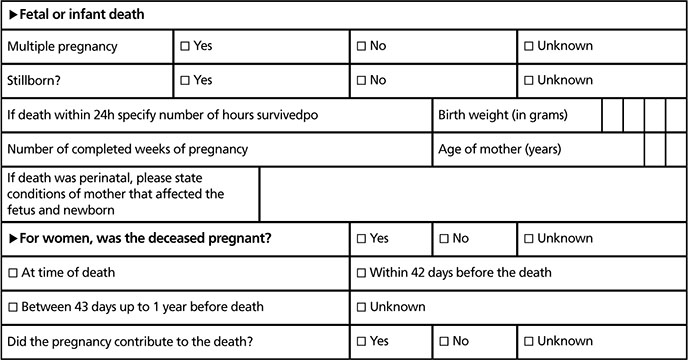J Korean Med Assoc.
2018 Apr;61(4):268-278. 10.5124/jkma.2018.61.4.268.
How to write a death certificate: from a statistical point of view
- Affiliations
-
- 1Department of Family Medicine, Myongji Hospital, Goyang, Korea.
- 2Vital Statistics Division, Statistics Korea, Deajeon, Korea. leon32@korea.kr
- KMID: 2409047
- DOI: http://doi.org/10.5124/jkma.2018.61.4.268
Abstract
- Although the enclosed rate of death certificates has steadily improved when domestic death notification to the government, the percent of well-certified causes of death is still 29th among the 35 Organization for Economic Cooperation and Development countries. The death certificate is a medical diagnosis how the deceased died, however, it is difficult to identify the causes of death such as cardiopulmonary arrest, unknown, and death due to old age were up to about 11%. The Statistics Korea selects the final cause of death by linking administrative records such as national health insurance records and national cancer registry data. The World Health Organization's the international statistical classification of diseases and related health problems, 10th revision, volume 2 manual, provides standard forms of death certificate and guidelines for how to write death certificates. It is necessary to provide the education materials or programs to the clinical doctors such as how differentiate the concepts of the underlying cause of death which is the basis of the death cause statistics, originating antecedent cause, main condition and the direct diagnosis of the death. Statistics on the causes of death are continuously needed to improve for the people's perception of death and to upgrade the quality of health care research and policy development.
Keyword
MeSH Terms
Figure
Reference
-
1. Statistics Korea. Annual report on the cause of death statistics in 2016. Daejeon: Statistics Korea;2017.2. Institute for Health Metrics and Evaluation. Global Burden of Disease Study 2016 (GBD 2016) data resources [Internet]. Seattle: Institute for Health Metrics and Evaluation;2016. cited 2018 Feb 2. Available from: http://ghdx.healthdata.org/gbd-2016.3. Shin HY, Lee JY, Song J, Lee S, Lee J, Lim B, Kim H, Huh S. Cause-of-death statistics in the Republic of Korea, 2014. J Korean Med Assoc. 2016; 59:221–232.
Article4. Vital Statistics Division. Statistics Korea. Shin HY, Lee JY, Song J, Lee S, Lee J, Lim B, Kim H, Huh S. Infant, maternal, and perinatal mortality statistics in the Republic of Korea, 2014. J Korean Med Assoc. 2017; 60:588–597.
Article5. Ministry of Health and Welfare. Medical Service Act Article 17 (Medical Certificates, [Internet]. Sejong: Korea Ministry of Government Legislation;2010. cited 2018 Feb 2. Available from: http://www.law.go.kr/lsInfoP.do?lsiSeq=106850#0000.6. Ministry of Health and Welfare. Medical Service Act Article 26 (Report on Unnatural Death) [Internet]. Sejong: Korea Ministry of Government Legislation;2010. cited 2018 Feb 2. Available from: http://www.law.go.kr/lsInfoP.do?lsiSeq=106850#0000.7. Ministry of Health and Welfare. Enforcement regulation of the Medical Service Act [Internet]. Sejong: Korea Ministry of Government Legislation;2017. cited 2018 Feb 2. Available from: http://www.law.go.kr/lsBylInfoPLinkR.do?lsiSeq=192275&lsNm=%EC%9D%98%EB%A3%8C%EB%B2%95+%EC%8B%9C%ED%96%89%EA%B7%9C%EC%B9%99&bylNo=0006&bylBrNo=00&bylCls=BF&bylEfYd=20170307&bylEfYdYn=Y.8. World Health Organization. International statistical classi-fication of diseases and related health problems 10th revision [Internet]. Geneva: World Health Organization;2016. cited 2018 Feb 2. Available from: http://apps.who.int/classifications/icd10/browse/2016/en.9. Ministry of Health and Welfare. Enforcement regulation of the Medical Service Act Article 9 (Certificate Prescription) [Internet]. Sejong: Korea Ministry of Government Legislation;2017. cited 2018 Feb 2. Available from: http://www.law.go.kr/%EB%B2%95%EB%A0%B9/%EC%9D%98%EB%A3%8C%EB%B2%95%20%EC%8B%9C%ED%96%89%EA%B7%9C%EC%B9%99.10. OECD.Stat. Health status data [Internet]. [place unknown]: Organization for Economic Cooperation and Development;cited 2018 Feb 2. Available from: http://stats.oecd.org/.11. Korean Medical Association. Cyber service training [Internet]. Seoul: Korean Medical Association;cited 2018 Mar 21. Available from: http://edu.kma.org.
- Full Text Links
- Actions
-
Cited
- CITED
-
- Close
- Share
- Similar articles
-
- Historical Changes of Korean Death Certificate Form
- The effect of education on ‘how to write the death certificate’ for resident trainees of the emergency department
- Analysis of Death Certificate Errors of a University Hospital Emergency Room
- Defect in Post-mortem Examination System Reviewed by the Realities of Death Certificate Issuing
- Review of Guide to Medical Certificate issued by Korean Medical Association




